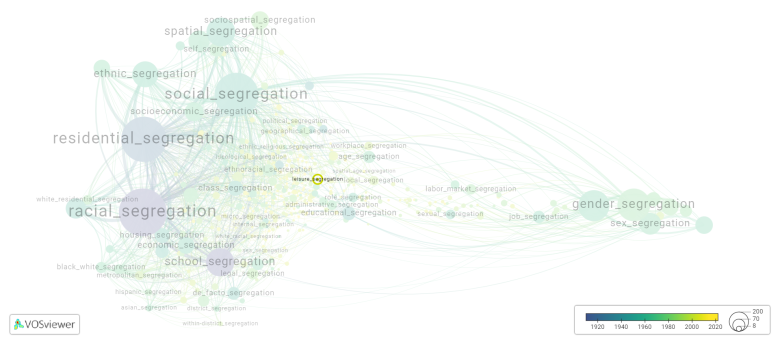Leisure segregation: Difference between revisions
(Creating page) |
(Creating page) |
||
| (5 intermediate revisions by the same user not shown) | |||
| Line 10: | Line 10: | ||
Efforts to address leisure segregation involve promoting inclusive leisure opportunities for all individuals, regardless of their age, gender, socioeconomic status, or other social factors. This can be achieved through the development of public leisure spaces that are accessible to all, the implementation of policies that ensure equal opportunities for participation, and the promotion of diversity and inclusion in leisure activities and facilities. | Efforts to address leisure segregation involve promoting inclusive leisure opportunities for all individuals, regardless of their age, gender, socioeconomic status, or other social factors. This can be achieved through the development of public leisure spaces that are accessible to all, the implementation of policies that ensure equal opportunities for participation, and the promotion of diversity and inclusion in leisure activities and facilities. | ||
==See also== | ==See also== | ||
==Related segregation forms== | |||
Leisure segregation is frequently discussed in the literature with the following segregation forms: | |||
[[ethnic segregation]], [[employment segregation]] | |||
[[File:leisure_segregation.png|780x780px]] | |||
This visualization is based on the study [[Segregation_Wiki:About| The Multidisciplinary Landscape of Segregation Research]]. | |||
For the complete network of interrelated segregation forms, please refer to: | |||
* [https://tinyurl.com/2235lkhw First year of publication] | |||
* [https://tinyurl.com/2d8wg5n3 Louvain clusters] | |||
* [https://tinyurl.com/223udk5r Betweenness centrality] | |||
* [https://tinyurl.com/244d8unz Disciplines in which segregation forms first emerged (Scopus database).] | |||
==References== | ==References== | ||
==Notes== | ==Notes== | ||
<references /> | <references /> | ||
{{NoteAI}} | {{NoteAI}} | ||
==Leisure | ==Leisure segregation appears in the following literature== | ||
Silm S., Ahas R. (2014). Ethnic Differences in Activity Spaces: A Study of Out of Home Nonemployment Activities with Mobile Phone Data. ''Annals of the Association of American Geographers'', ''104''(3), 542-559. Routledge.https://doi.org/10.1080/00045608.2014.892362 | Silm S., Ahas R. (2014). Ethnic Differences in Activity Spaces: A Study of Out of Home Nonemployment Activities with Mobile Phone Data. ''Annals of the Association of American Geographers'', ''104''(3), 542-559. Routledge.https://doi.org/10.1080/00045608.2014.892362 | ||
Marucco C. ( | Marucco C. (202). Integration and Segregation through Leisure: The Case of Finnish Somalis in Turku. ''Nordic Journal of Migration Research'', ''10''(3), 90-104. Helsinki University Press.https://doi.org/10.33134/NJMR.327 | ||
Latest revision as of 07:17, 16 October 2024
Date and country of first publication[1][edit | edit source]
2014
Estonia
Definition[edit | edit source]
Leisure segregation refers to the separation or division of individuals or groups based on their leisure activities or preferences. This can occur in various forms, such as the separation of different age groups in public leisure spaces, the division of people based on their socioeconomic status in recreational establishments, or the exclusion of certain groups from participating in certain leisure activities due to discrimination or social barriers.
Leisure segregation can have negative impacts on individuals and communities. It can lead to the creation of exclusive leisure spaces that only cater to certain groups, further perpetuating inequality and marginalization. It may limit the opportunities for social interaction and integration between different segments of society and reinforce the social divisions already present. Additionally, leisure segregation can create a sense of isolation and exclusion for those who are unable to access certain leisure activities or spaces.
Efforts to address leisure segregation involve promoting inclusive leisure opportunities for all individuals, regardless of their age, gender, socioeconomic status, or other social factors. This can be achieved through the development of public leisure spaces that are accessible to all, the implementation of policies that ensure equal opportunities for participation, and the promotion of diversity and inclusion in leisure activities and facilities.
See also[edit | edit source]
Related segregation forms[edit | edit source]
Leisure segregation is frequently discussed in the literature with the following segregation forms:
ethnic segregation, employment segregation

This visualization is based on the study The Multidisciplinary Landscape of Segregation Research.
For the complete network of interrelated segregation forms, please refer to:
References[edit | edit source]
Notes[edit | edit source]
- ↑ Date and country of first publication as informed by the Scopus database (December 2023).
At its current state, this definition has been generated by a Large Language Model (LLM) so far without review by an independent researcher or a member of the curating team of segregation experts that keep the Segregation Wiki online. While we strive for accuracy, we cannot guarantee its reliability, completeness and timeliness. Please use this content with caution and verify information as needed. Also, feel free to improve on the definition as you see fit, including the use of references and other informational resources. We value your input in enhancing the quality and accuracy of the definitions of segregation forms collectively offered in the Segregation Wiki ©.
Leisure segregation appears in the following literature[edit | edit source]
Silm S., Ahas R. (2014). Ethnic Differences in Activity Spaces: A Study of Out of Home Nonemployment Activities with Mobile Phone Data. Annals of the Association of American Geographers, 104(3), 542-559. Routledge.https://doi.org/10.1080/00045608.2014.892362
Marucco C. (202). Integration and Segregation through Leisure: The Case of Finnish Somalis in Turku. Nordic Journal of Migration Research, 10(3), 90-104. Helsinki University Press.https://doi.org/10.33134/NJMR.327
